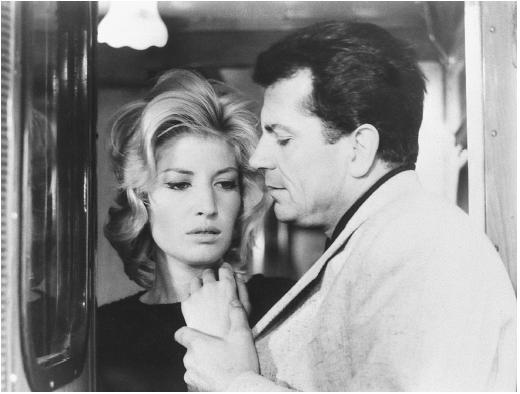 Warning: the following post contains spoilers.
Warning: the following post contains spoilers.If, as is rumored, The Romance of Astree and Celadon proves to be octogenarian writer-director Eric Rohmer's final film, the nouvelle vague's senior auteur will have accomplished something truly remarkable - and perhaps even unprecedented for a film director of his level of productivity: namely, Rohmer will have completed a feature filmmaking career spanning nearly fifty years and some twenty-plus features without having once directed a single work of even middling quality. This is not to say that The Romance of Astree and Celadon is merely 'good'; perhaps more than even his late masterwork The Lady and the Duke (2001), The Romance of Astree and Celadon serves to consolidate and even extend a number of the director's key themes. This is to say that The Romance of Astree and Celadon is truly up to the extraordinary task of being the director's finale, not that we wouldn't relish more still from one of the medium's supreme masters.
Adapting Honoré d'Urfé's novel of 5th century Gaul life, The Romance of Astree and Celadon claims to reproduce less the period depicted than its 17th century readers' imagination of the earlier period. Commensurate with this goal, the director features canvases painted in the seventeenth century, a castle built well after the novel's setting and importantly a grafting of the Christian faith onto the Druid-themed source material. Also Rohmer, in typical hyper-realist fashion, apologizes for setting the film in a location other than that represented in the novel - as per the place's disfiguration in the coming industrial centuries. That is, rather than utilizing matte painting to substitute for that which could not be recreated with a high degree of verisimilitude (as he does with the 18th century Paris of The Lady and the Duke) Rohmer substitutes locations, confirming the place that the environment plays in his pastoral narrative.
Indeed, this untrammeled nature appears on both the sun-dappled 16mm cinematography (on the same format he used for his supreme masterpiece Summer [The Green Ray; 1986]) or in the ubiquitous bird songs that fill the film's soundtrack. Hence, The Romance of Astree and Celadon serves to synthesize Rohmer's hyper-stylized period work (The Marquise of O, Perceval, The Lady and the Duke and Triple Agent) and the naturalist ethos of his contemporary corpus (everything else): here we have a film that maintains Rohmer's interrogation of the problematic of period recreation, while introducing a series of natural locations that define his more widely-appreciated present-day works.
In these landscape, Rohmer commences with a misunderstanding between the film's eponymous lovers, Astree (Stéphanie Crayencour) and Celadon (Andy Gillet), where the former sees her male paramour in the arms of another - comparable to a similar misunderstanding appearing late in An Autumn Tale (1998) that features Rohmer axiom Marie Rivière, who also appears as Celadon's mother (uncredited) in this opening scene. Following Astree's clandestine sighting of Celadon, the young woman states her desire to never again see Celadon, leading the latter to attempt suicide. Suffice it to say that he survives his attempt, though he does find himself in the presence of three nymphs (including a second Rohmer regular Rosette).
Of course, it is in their amorous company that Celadon's love will be put to the test, as so often occurs in Rohmer's universe. Likewise, this theme of fidelity - similarly characteristic for the director's corpus - allegorizes religious faith, though in the case of his latest it is with the added valence of a pre-Christian Druidism that nonetheless sounds an awful lot like the director's trinitarian Catholicism. Here, we have Celadon's philosopher of love brother arguing the case for fidelity - where magically two lovers become the same person - versus the musician's philanderer, who says we love what he have yet to carnally love. He is the unbeliever, the film's Antoine Vitez to its Jean-Louis Trintignant (i.e. the Marxist philosopher and the Catholic in My Night at Maud's [1969] to which The Romance of Astree and Celadon shows an unexpected resemblance). And like that film, Rohmer's latest establishes the conflict through conversation before providing its double in the consequent plot.
In the film's closing passages, among the most absolutely sensual in the contemporary cinema, Celadon, resolute in keeping his promise to remain forever out of Astree's sight, takes on the appearance of a Druid priest's missing daughter - after encountering her sleeping body (and uncovered legs - cf. Claire's Knee [1970] in a forest grove). Soon thereafter, her bare snow white breast proves too much for the frustrated Celadon, which compels the costumed lead to passionately grope his soul mate. Noticing that her girlfriend has no chest, she asks Celadon who (s)he is. Having since changed into her clothes, Celadon responds he is Astree, thereby literalizing the construct introduced by the former's brother. With his identity thereafter disclosed, Astree jubilantly responds "live, live, Celadon," with only the closing credits to follow. As such, Rohmer gives us a truly great ending - surpassed in his corpus only by the single "oui" that concludes Summer - to what may prove his truly great final film.




























